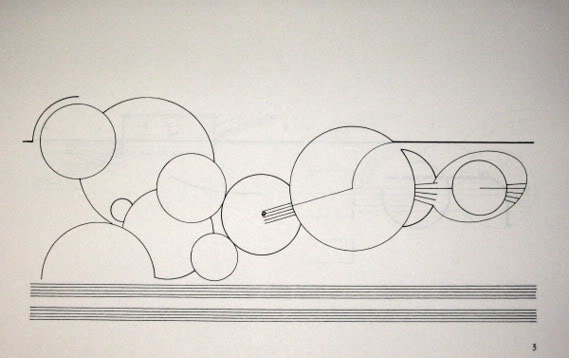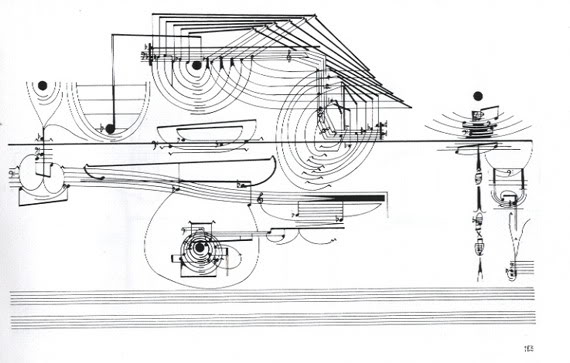Brian Lund, Selected Edit Cuts from Sweet Charity and Lenny [detail], 2008
If you squint in front of Brian Lund’s latest series of drawings, his colorful, wiry masses of lines and shapes begin to look like Rorschach figures stripped of their flesh, rendered as angular skeletons. Eyes wide open, closer to the pieces, which are alternately tacked to and framed on the walls of Smith-Stewart, even more curious things appear in the form of text and notations: sequential numbers that snake around the paper, blocks of hatching, repeating patterns of circles, squares, and words. “Charity hope valentine” appears over and over again in one piece. “Lenny Bruce” is sprinkled liberally on the page.
Brian Lund, Selected Edit Cuts from Sweet Charity and Lenny, 2008
The drawings, one learns on consulting the press release, are the result of Lund translating the “vast editing systems of Hollywood films into abstract compositions” using his own system of notation. Here, he takes Bob Fosse’s films as his foundation. His impenetrable vocabulary suggests Cornelius Cardew’s musical scores from the 1960’s, which stretched and morphed the basic units of Western musical notation. Like Cardew’s Treatise, the viewer is left to make sense of a score littered with only barely recognizable figures. A few passages make sense; others yield only static.
Mark Lombardi
The key difference between Lund and Cardew, of course, is that the former is working after the fact, building a record of a completed work. Are we supposed to be able to piece together a narrative by looking at the work? (Could this be visual art’s Dark Side of the Moon / The Wizard of Oz moment?) By providing numbers (some marker of time, cuts, or frames?), Lund seems to be teasing a chance at legibility. Maybe we can work it out if we look a little closer. His work, then, sits somewhere near Marc Lombardi, whose overflowing schematics lead to a similarly fractured language and stifled relations. Their drawings denote the boundaries of all closed, specialized languages.

Cornelius Cardew, Treatise [page 3], 1963-67
As rigorous as Lund’s conceptualism is, the controlled effervescence of his work (one thinks of Julie Mehretru) is what allows him to avoid crafting a vapid tribute to 1970’s systems art. Asked to diagram one of these films again, it is hard to believe that Lund would perfectly recreate every element of the complex network of signs and lines. Here, the artist mediates the system. Forced to toss out the foundational text, one gets the impression that he would still want to make exactly these types of drawings. If he gets bored with film, that’s good news.

Cornelius Cardew, Treatise [page 183], 1963-67
Cornelius Cardew, Treatise [page 3], 1963-67
As rigorous as Lund’s conceptualism is, the controlled effervescence of his work (one thinks of Julie Mehretru) is what allows him to avoid crafting a vapid tribute to 1970’s systems art. Asked to diagram one of these films again, it is hard to believe that Lund would perfectly recreate every element of the complex network of signs and lines. Here, the artist mediates the system. Forced to toss out the foundational text, one gets the impression that he would still want to make exactly these types of drawings. If he gets bored with film, that’s good news.
Cornelius Cardew, Treatise [page 183], 1963-67
53 Stanton Street
New York, NY
Through March 1, 2009

No comments:
Post a Comment